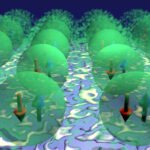When electrons slowly vanish during cooling
Researchers observe an effect in the quantum world that does not exist in the macrocosm
Scientists from the University of Bonn and ETH Zurich have made significant progress in understanding phase transitions in exotic quantum materials. Phase transitions occur when substances change their properties, and they are typically described by classical physics. However, in the quantum realm, the laws governing matter’s smallest building blocks, such as electrons, can lead to unusual phase transitions not observed in the macrocosm.
The researchers focused on continuous phase transitions, which involve gradual changes in a material’s properties. They found that fermions, the particles that make up matter, typically do not play a role in phase transitions because they cannot be destroyed due to fundamental laws of nature. Instead, phase transitions are typically based on the behavior of bosons, particles that generate interactions like magnetism.
However, in certain exotic quantum materials, fermions and bosons can combine to form quasiparticles. These quasiparticles have unique properties, existing in a superposition of immobility and mobility. The researchers discovered that these quasiparticles can be destroyed during a phase transition, leading to a phenomenon called “critical slowing down.”
The team developed a new method to directly identify the collapse of quasiparticles during a phase transition, providing direct evidence of critical slowing down in fermions. Previously, this effect could only be observed indirectly.
The findings contribute to a better understanding of phase transitions in the quantum world, which could have implications for quantum information technology in the future. The study was a collaborative effort between ETH Zurich and the University of Bonn, with funding from the Swiss National Science Foundation (SNF) and the German Research Foundation (DFG).



































